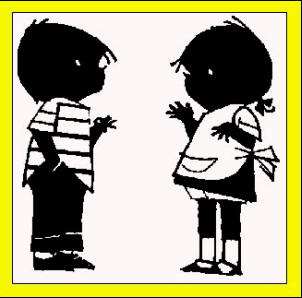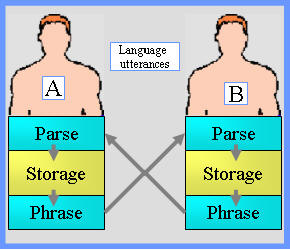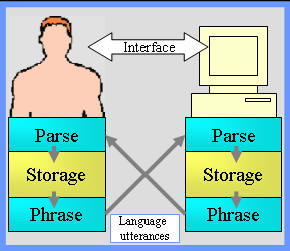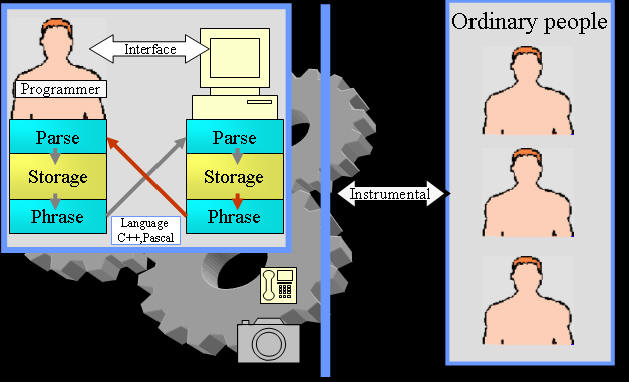| 1 Communication | 2 Elements | 3 Engine | 4 Small application | 5 Heavy application | 6 Download | 7 Notes |
![]() 1 Communication cycle
1 Communication cycle
1.1 Introduction
Observation: most of the (declarative)
knowledge people acquire in their youth and apply in their ordinary life is not
devised by themselves but fabricated by wise men in past and present. This
knowledge is transferred by means of communication.
The purpose of CommunSENS is to build a knowledge engine that can be a node in
this communication cycle.
| Figure 1.1: Knowledge transfer by means of communication. | |
 |
I have
an uncle, Janneke says.
Puhh,
Jip says, I have four of them. Four uncles.
But my
uncle has a beard, Janneke says.
That
was too much for Jip.
|
|
Jip en Janneke; door Annie M.G. Schmidt
|
|
A nice example of knowledge transfer by means of communication is given in
figure 1.1.
At the start of the dialog both children have a certain knowledge
state. When the communication cycle stops, their knowledge state has
changed. Janneke knows that Jip has four uncles. Jip knows that Janneke
has an uncle with a beard.
It is important to note that the knowledge state of the children is fully
scalable. To put it into the words of a computer programmer: the
knowledge is added at run-time, without stopping and rebuilding the system or
generating additional code.
1.2 The classic physiology of the communication cycle
The success of the species homo sapiens is caused by its ability to accumulate knowledge by means of the communication cycle. This cycle can be associated with certain parts in the human brain: the hardware. The next figure gives a general idea of these relevant parts.
| Figure 1.2: The classic physiology of the communication cycle | |
|
|
1) Knowledge
carrier: verbal or written utterances. 2) In Wernicke’s area the incoming utterance is processed. This area is associated with lexical analyses and parsing. 3) Broca’s areas is usually associated with the capability to put symbolic knowledge into words: naming and phrasing. 4) The motor cortex enables the pronunciations of the words. |
| http://www.ling.upenn.edu/courses/Spring_2001/ling001/language_brain.html [Broken Link] | |
The cycle starts with a knowledge carrier: verbal or written utterances. In the case of Jip and Janneke such an utterance is for example the sentence: 'I have an uncle'. This sentence reaches Jip's ear and is transferred to an area in the brain called Wernicke's area. In that area the individual words of the sentence are recognized. In the same area the structure of the utterance is decoded. For example, in the utterance 'I have four uncles' it is important to know that 'four' relates to 'uncles' and not to 'have'. The operation in which words get the right position is called parsing. After parsing it is possible to store the contents of the utterance as symbolic knowledge somewhere in the brain.
When Jip has stored the information about Janneke's uncle he can add his own information to it. Somewhere in Jip's brain there is symbolic information stored about four uncles. This symbolic information is retrieved and processed in Broca's area. There it is put into words (naming). Next these words are structured in a sentence (phrasing). After that, a signal is given to the motor cortex in order to articulate the utterance: 'I have four of them. Four uncles'. This triggers the next stage in the communication cycle.
Figure 1.3 summarizes the necessary elements of the communication cycle
| Figure 1.3 Elements of the communication cycle | |
 |
Syntax - Parse - Phrase Semantics - Name - Recognize Network - Store - Retrieve Language utterance - Spoken - Written |
Up till now we discussed the communication between 2 persons at the same time. However, knowledge transfer is not limited to the present but it also links to the past. An important part of our knowledge is invented by previous generations. The transfer mechanism is much the same. The main difference is that time restricts the feedback. For example, in figure 1.4 there is no way that Aristotle could have communicated with Socrates or that we can communicate with Plato. However, the idea's of these men has come to us and they profoundly influence our daily lives.
| Figure 1.4 The communication cycle in time: accumulation of knowledge |
|
|
1.3 The architecture of CommunSENS
The main architecture of CommunSENS is a direct derivative of the classical physiology of the communication cycle. To let the computer be a node in the communication cycle it must be equipped with a parser, a storage medium and a a phraser. This situation is pictured in figure 1.5.
| Figure 1.5: Man - machine communication | |
 |
Elements needed Fonal: a formal natural language in which men and machine can express them selves CHI2: a semantic network for storing and retrieving knowledge Interface: dialogs for entering and showing information. |
In order to build a parser and a phraser, one has to decide on the language in
which men and machine express them selves. For that purpose a formal natural
language has been designed. The language is formal because the computer still
needs its input in a rather formalized way. The language is natural
because its structure is based on the universal structure of human languages.
The main goals of the language are that Fonal is expressive and that
ordinary
people can better understand it.
As a storage medium a universal database has been designed that behaves as a
semantic network. Although the communication between man and machine can occur
in language utterances only, an additional user interface has been designed for
entering and showing information, This interface is related both to the parser
(input) and to
the phraser (updates).
1.4 Added value
To judge the added value of this architecture, consider today's main use of computers as illustrated in figure 1.6. The most obvious feature of the illustration is that only half of the communication cycle is used. At the side of the machine there is no phraser that can systematically put stored knowledge into words 1). A second obvious feature is that ordinary people can not communicate with the computer in a direct way. They need a programmer as a middle man. In order to decide whether these features pose a serious problem or not, one has to differentiate between static and dynamic knowledge.
| Figure 1.6: Today's use of the computer is mainly instrumental |
 |
Static knowledge
Only computer programmers
can communicate with computers. A programmer is a person that can put knowledge into words
using a language that the computer understands, but most humans do not. For
example, a programmer can have knowledge about the way one should work with a
word processor. He communicates this knowledge using a computer language to the
machine. There it is parsed and stored as a so called 'executable'. Ordinary
people can run this executable and use it as an instrument, much in the same way
as
they use a camera or a telephone. There is no transfer of knowledge; there is instrumental use
only. This use of computers is appropriate under the
conditions that the nature of the knowledge is rather static. For example the
knowledge about word processing is not subject to
permanent change. Therefore, the
need to communicate about this kind of knowledge will not be very high.
Dynamic knowledge
If the nature of the stored knowledge is dynamic this
approach will not work.
Updating the knowledge will be very laborious. Consider a workflow system that
has been designed to enforce governmental regulations. As we all know these
regulations can change very often: new rules are invented, existing rules change,
the context in which the rules operate changes etc. In such circumstances it is
necessary that the knowledge state of the engine can be changed,
at all levels, at run time.
CommunSENS architecture allows you to do so. By using the communication cycle as
its paradigm, fully scalable knowledge applications can be build.
1) The activity that comes nearest to phrasing is probably 'reverse engineering'.
| 1 Communication | 2 Elements | 3 Engine | 4 Small application | 5 Heavy application | 6 Download | 7 Notes |
Copyright © 2005 by AB Ontwikkeling BV
All Rights Reserved. Any reproduction or reuse of these pages or
their contents requires the advance permission of AB Ontwikkeling BV.